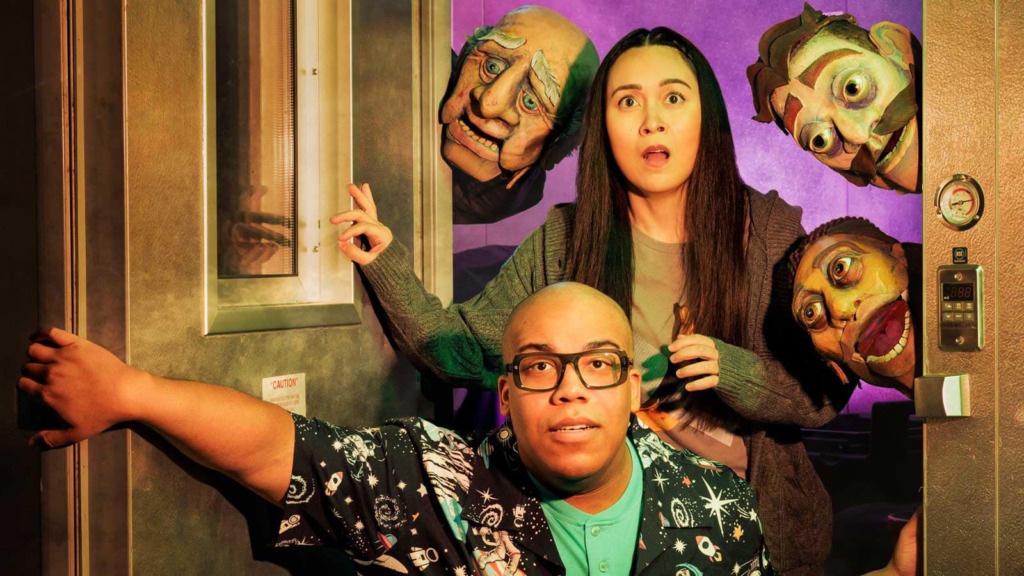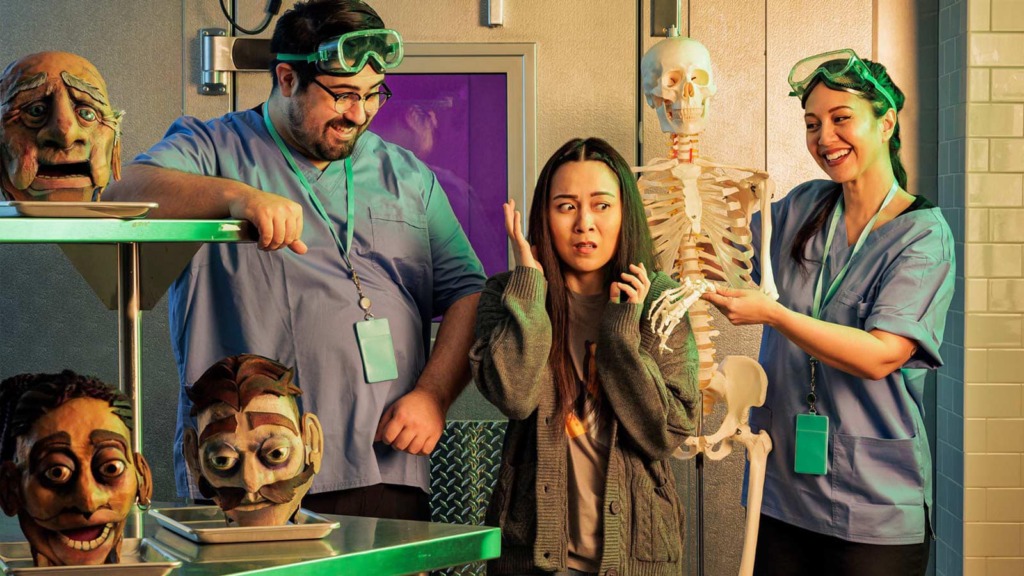Dead bodies are the worst! Or are they? I mean, is there anything worse than your parents naming you ‘Eyeballs’? Yes. Your parents naming you ‘Pitfall.’ Okay, not literally, but what if you figured out at the ripe old age of 13, which is a challenging age all on its own, that your name translates in Latin to the word ‘eyeballs’ or ‘pitfall’ or worse, ‘depression’? Wouldn’t that be enough to set you spinning into chaos? Add to the mix some talking— well, harmonizing and singing— disembodied heads, blackmail, and a grandma who is obsessed with planning her own funeral— and you’ve got a wildly engaging, fully entertaining, and totally relatable seventh grade experience, even if your name isn’t ‘Eyeballs.’ That’s what’s unfolding, unfurling, and totally happening with The Mortification of Fovea Munson, a brand-new kids musical commissioned by The Kennedy Center, making its world premiere in the Family Theatre. Adapted from Mary Winn Heider’s book, with music & lyrics by Justin Huertas, this poignant and darkly humorous narrative breathes lives into all of the skeletal complications of being a teenager when one’s parents run a cadaver lab and expect you to take over the family business. Directed by M. Graham Smith, with Musical Direction & Orchestrations by Steven Tran, and Choreography by Ashleigh King, this fabulously morbid tale of growing up and figuring out who you want to be is something everyone can learn from.

Creepy and kooky and all together spooky in the best and newly innovative way possible, the stage of the Family Theatre at the Kennedy Center undergoes a slightly warped transition to become the play-space for The Mortification of Fovea Munson. Scenic Designer Arnel Sancianco working in tandem with Lighting Designer Lee Fiskness has kitted out the stage in a fashion not dissimilar to something straight out of a funhouse distortion room. It’s got just enough of an unsettling feeling to be a little spooky in a fun and not-really-frightening way. The use of eerie-undead-green and vivacious otherworldly purple augments this frightening-but-fun atmospheric feel and the slightly wobbly checker-patterned floor adds to the overall playful peculiarity of the set.
The show amps up the oddities with the fabrications of Puppet Master-Designer Erik Teague, who doubles up as the show’s costume designer. Teague’s work— both with the full-body-suit UV-reactive frog-puppet-costume and the disembodied head-puppets— add an extra layer of fascination to the performance and bring a level of intrigue to the show that could have otherwise been lost without his unique expertise. As three of the characters— Andy, Lake, and McMullen— are…specimens from Fovea’s parents’ cadaver lab (specifically disembodied heads. That talk. And sing.)… Teague’s design work becomes an integral part of the show’s enjoyment. Having floating puppeted heads (puppeted and voiced by three of the company’s actors) allows for these characters not only to exist and advance the story but for them to participate in the show’s energetic and enthusiastic choreography. Teague’s work is clever and unique, perfectly balancing the levels of humorous and unsettling so that the puppets are far more laughable and enjoyable than scary or frightening. The frog-suit and Grandma Van’s teal and hot-magenta windbreaker jacket covered in rhinestone skull prints are Teague’s two most impressive costumes.
The music and lyrics for the show, along with the show’s orchestrations come from the duo of Justin Huertas and Steven Tran. The pair place really smart lyrics together that are quirky and humorous while also being poignant and heartfelt, all overtop of a unique musical canvas that has some catchy earworm-style melodies bouncing along in the background. (The show lists no official song list in its program.) But the opening number, which might be titled “Dead Bodies are the Worst” has a funky up-tempo drive to it, and really gets the electric wow-factor going straight from jump-street. Mary Winn Heider’s story is both creative and universally accessible. At its core, the show’s protagonist, a young teenager, is trying to come to terms with her own existence, not wanting to grow-up to do what her loveable, oddball parents want her to do, and to find her own way despite everything that’s happening all around her. The nuance of Heider’s work is in all the deliciously delightful and slightly morbid details. Fovea Munson is the daughter of two cadaver-lab scientific-surgeons who teach medical students/prospective surgeons operating techniques by using cadavers. She has a Filipino grandmother who is obsessed with dying and planning her own funeral, and at the very beginning of the story, Fovea’s best friend just ditches and abandons her for basically no reason. Heider’s work is the perfect encapsulation of the 7th grade/13-year-old experience: not knowing who you are, how to tell your parents that you don’t necessarily want to grow up and do what they do/what they want you to do, and how to accept all sides of your experiences in life as they come at you. What makes the show so special, in addition to all of Huertas and Trans’ catchy music and smart lyrics, is the universality and overall poignant heart that Heider situates at the center of it. The lessons learned— that it’s okay to be different, that it’s okay to not want to do what your parents do, that it’s okay to have different parts of who you are that are different from all the other parts— regardless of how they’re portrayed (in this story it’s through lightly darkened morbid humor) are important ones for children, children at heart, and those accompanying children to the theatre.

Director M. Graham Smith and Choreographer Ashleigh King put their skillset to the test with this production of The Mortification of Fovea Munson. There’s three disembodied heads who want to be a barbershop quartet (already that’s a problem as a quartet needs four people…), there’s a sinister crematorium creeper who wants to bring blackmail into the deal, there’s dissections of frogs*, and of course, Grandma Van’s scooter, which is one of the funniest arrival jokes threaded into the show, and a whole host of other things that keep the show churning at a frantic and frenetic pace. King keeps the dance moments popping; the title number has this disco-nightmare-trippy vibe to it that just defies description in the best way possible. Smith (with assists from Stage Manager Julia Singer and Assistant Stage Manager Genevieve Dornemann) runs a tight ship. All of the actors, with the exception of the two playing Fovea and Howe, double up as multiple characters throughout the performance, each gliding swiftly out of scenes, flipping costumes, and reappearing practically in the blink of an eye. It’s an impressive and exciting production and the creative team— spearheaded by Smith, Tran, King, Huertas, and Heider— bring all the components of a well-crafted, thoroughly enjoyable musical for young audiences (that also delights those young at heart and those accompanying the young audience members) to the stage in this vivacious show.
The company of performers— Regina Aquino, Jonathan Atkinson, Dylan Arredondo, Christopher Michael Richardson, Michael Mainwaring, Justine “Icy” Moral, Farrell Parker— do a stupendous job of keeping the show engaging, understandable, and thoroughly entertaining. These seven individuals have an impeccable understanding of how to deliver a musical for young audiences in a way that is both engaging and entertaining for everyone. The overly animated facial features on Jonathan Atkinson, Dylan Arredondo, and Michael Mainwaring (who puppet and voice the disembodied head specimens of Andy, McMullen, and Lake, respectively) are thrilling to watch, especially when they’re singing along in their “midnight concert” scene. Atkinson also plays the villainous Inko, a ghoulish and nefariously motivated Crematory-person who gets his own slinky, sleazy, slimy number with nods to tin-pin alley and jazzy swing-big bands of a bygone era of stage villain. Dylan Arredondo also plays Fovea’s Father, a quirky and kooky individual who is just delightful to watch in action, especially when paired opposite of Fovea’s Mother, played by Regina Aquino.

While Regina Aquino plays a fun-loving, albeit oddball, mom, her real moment to shine is as Grandma Van, who is arguably the most hilarious character in the performance. Aquino’s deadpan timing and sudden arrivals (via tricked-out scooter) are hysterical and her overall attitude toward Fovea, as the sarcastic yet clearly sagely grandmother, is simply wonderful.
The only two performers who aren’t doubled up in the production are Christopher Michael Richardson, who plays Howe, the unlikely but totally loveable super-student who is in every single club, super nerdy, and insanely vocally talented. And of course, Justine “Icy” Moral as the title character of Fovea. The unique friendship that blossoms between the Howe and Fovea characters is really special, particularly as it comes about in a curious and unexpected, largely circumstantial way. Richardson’s tenor voice is stunning and he really give the barbershop quartet numbers a lot of extra sparkle and pizazz. As for being Fovea Munson, Justine “Icy” Moral has perfectly captured the essence of a 13-year-old girl who has exactly no idea what she wants to do with her life, other than not wanting to be a part of her parents’ cadaver lab when she gets older. The emotional transitions and roller coaster performance that Moral gives on stage feels so authentic that if you didn’t know better you’d swear she was a teenager. Especially in her moments of really breaking down all of the problems and chaotic factors in Fovea’s life— like thinking that she’s failed to live up to her parent’s expectations or that she’s responsible somehow for the calamity that’s crashing down upon the cadaver lab— you get a sense of earnest and genuine pathos, that Moral really connects with the Fovea character on an intrinsic level. And her singing voice is really impressive too.
So dead bodies probably aren’t the worst— especially if they’re singing at you and helping you figure out what it is that makes you happy or what it is that sets you on the course of life that you want to be on. This innovative, creative, really touching, and totally fun new musical— The Mortification of Fovea Munson— is only hanging around for a couple of weeks, so don’t miss your chance to check it out before it checks out for good.
Running Time: Approximately 85 minutes with no intermission
The Mortification of Fovea Munson plays through March 19, 2023 in the Family Theatre of The John F. Kennedy Center for the Performing Arts, 2700 F Street NW, Washington, DC. For tickets call the box office at (202) 467-4600 or purchase them online.
To read the interview with author & librettist Mary Winn Heider, click here.
